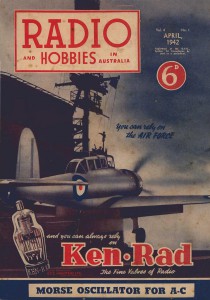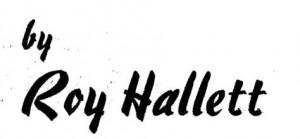Historical article:
Since the very first issue of Radio and Hobbies, (April 1939), it has been a matter of policy to provide, each month, the best possible information for short-wave listeners. However, we have often wondered how many of our readers are interested in long distance and overseas reception on the broadcast band. Here are some broadcast band DX notes, compiled by Mr. Roy Hallett. If you are interested, drop us a line and we will see what can be done about making this a regular feature.
Many radio listeners, seldom, if ever, try to receive overseas stations on the Broadcast band, many of them don’t believe it possible. I live eight miles from the heart of’ Sydney, and on my 6 valve receiver, made from a circuit described in “Wireless Weekly,” in 1936, I have heard stations on every continent, with the exception of South America and Africa.
It Is not always possible, unfortunately, to receive long distant stations, as some locations are unfavorable for such reception. A fairly good aerial is essential. However, I heard KGMB Honolulu, Hawaii, one night on a three-valve 1928 model receiver, with the aerial attached to a branch of a tree outside the window.
VERIFICATION CARDS
The majority of these stations, like the short-wave stations, send out verification cards or letters. Some of these cards are very attractive, and some interesting literature and letters have been received by the writer, and other DX’ers I know, from medium-wave stations both in this country and overseas. Australian medium-wave stations also send out cards and letters. Many of these cards are well worth having.
Stations on the broadcast band are seldom as strong as those heard on short-waves. It is, however, possible to follow a news bulletin fairly easily from American, Asiatic, European, and, of course, many New Zealand stations. Under favorable conditions, stations in these parts of the globe reach good signal strength, and some musical, or other types of programmes, may be thoroughly enjoyed.
REPORTS WELCOMED
Reports from our readers concerning their reception of broadcast band stations overseas would be very welcome. Your criticisms on this section and any questions you may have to ask concerning this hobby would be greatly appreciated. Please address your communications to the writer at 36 Baker-street, Enfield, Sydney.
JF you are keen on Broadcast Band DX, you are invited to send in reports of stations received and other relevant news to Mr. Roy HaIlett, who is responsible for compiling this material. Letters may be addressed direct to Mr. R. Hallett, 36 Baker-street, Enfield, NSW. Alternatively they may be addressed C/o Mr. W. N. Williams, Technical Editor, Radio and Hobbies, 60.70 Elizabeth-st., Sydney.
Here is a brief summary of stations likely to be heard in Eastern Australia during the next month or so.
NORTH AMERICA
Stations in North America are being heard at present after our local stations close at night, leaving clear channels, till they fade out at about 1.30 a.m.. These are usually the best of them:—
KFI, Los Angeles 640kc. Fairly strong, but interfered with by a Chinese station.
KPO, San Francisco, 680kc. One of the best of these, fairly good around midnight and 1 am. It is fairly consistent.
KOA, Denver, 850kc. Fair, with news at midnight.
KIRO, Seattle, 710kc. Fair around 1 am.
KNX, Hollywood, I070kc. Fairly good from 12.30 am, fades around 1.30.
KSL, Salt Lake City, 1160kc. Opens at fair strength, II pm.
WOAI, San Antonio, I200kc. Fair between II and 11.30 pm, sometimes later.
ASIA
Asiatic stations are heard best during our winter months, but the following are audible at present. These broadcast native type programmes, but the 11.30 news from Dacca is in English.
XGAP, Peking, China, 640kc. Fair from just after midnight till a few hours later, when it closes. Sometimes spoilt by KFI.
XOJC, Nanking, China, 660kc. Not very strong, heard around midnight.
HS7PJ, Bangkok, Thailand, 825kc; Fair around 1 am.
VUY, Dacca, India, 1167kc. May be heard with news relayed from Delhi at 11.30 pm favorable nights; audible till around 3 am.
NEW ZEALAND
The easiest of the overseas countries for Eastern Australians to hear on the broadcast band is our Sister Dominion, New Zealand. Some excellent signals are available from NZ now at night. Try these:
2YA, Wellington, 670kc. News 8 pm, closes 10.30 pm.
1YA Auckland, 650kc. News 8 pm, closes 10.30 pm. A relay is taken from the BBC at 10 pm.
2YC, Wellington, 840kc. This station apparently closes down at 9.30 pm.
EUROPEAN STATIONS
European stations are heard at quite good strength just before sunrise during our summer months. Some are likely to be heard for a while yet. Incidentally, Europeans as a rule don’t use call signs on medium waves.
Radio Sofia, Bulgaria. 850kc.
English National stations, 1149kc., often taking the EEC service to Europe, heard on the SW European service stations.
Nice, France, 1186kc.
Rome, No. 2, Italy, 1222kc.
Rome, No. 1, 713kc,
Breslau, Germany, 950kc.
Konigsberg, Germany, 1031kc.
These are usually heard from around 4.30 am till sunrise.
STOP PRESS
The times quoted in each case are daylight saving times. It now appears that daylight saving is to be discontinued as from April 1, and due allowance will need to be made for this. Subtract one hour from all times quoted.
Footnote: This column only survived until the June 1946 issue of R & H. The Shortwave column however, continued being published for many years after this date.





